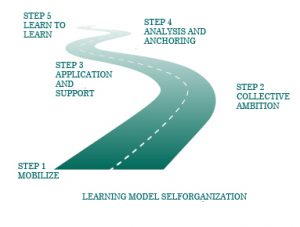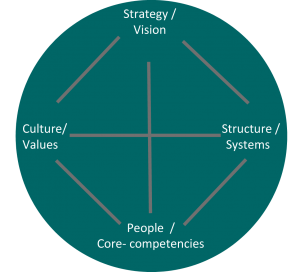Do-it-yourself leaders

Do-it-yourself leaders
We talk a lot about self-management and self-organization. But how can we start applying it? What are traps, what the invisible strengths? And what implies self-organization for you as a leader. This book (only in Dutch) and the workshops teach you on each of the 3 important levels for self-organization: individual, team and organization wide to start applying it. Highly representative cases from practice illustrate how other companies evolved applying self-organization step by step. This results in a unique guide to help you making the challenging step towards self-organization.
Together with 25 contributors from our learning platform on self-organization we gathered data and examples of organizations applying aspects of self organization. This led to 16 interesting cases – small and big, profit and not for profit.
Some examples illustrate the usefulness of small experimental activities limited to only one team, or part of an organization. Others present a ‘total approach’ to applying self-organization.
The book is structured by using 3 system levels, a 5-step learning model and an organization window.
1. First the 3 system levels:
Self-organization (the whole organization) includes all practices, activities and processes through which individuals, teams and organizations blossom and grow from within. Self-organization, being the overall level – including the other two: self-steering teams and self-leadership.
It is made possible because these organizations provide maximum space for autonomous growth – and horizontal functioning on an equal basis – instead of top-down. Some people use the term self-management instead.
Self-steering teams are flexible teams or workgroups – not necessarily the entire organization – who have enough space to manage their own workflow and processes. They are able to set their own goals and mostly define / chose who their members are and who is taking what role. For a shorter time or during a longer period.
Self-leadership is about dealing with the individual will and capacity to question and develop oneself. This can be within an organization and or a team but not necessarily, you can also apply it on your own, outside the work-context as well.
2. A 5 step learning model for self-organization:
Over the last few years I have been busy studying, facilitating and helping organizations with various initiatives for self-organization. These experiences, and shared learning with our learning platform, have resulted in the development of a learning model for self-organization. It is a dynamic model for applying self-organization. It is intended to help people interested in self-organization, it is not a miracle toolkit or approach!
 An overview of the 5 steps:
An overview of the 5 steps:
Step 1 Mobilize – This is a required phase in every change project– particular to self-organization is the fact that people often cannot imagine what it feels like or conceive its practical application. Therefore it is important to offer (a group) of employees a tangible experience with aspects of self-organization to enable them to perceive and internalize its real possibilities e.g. during a ‘taster’ workshop. I have gathered a lot of positive experiences with these kinds of ‘initiators’, after which participants are eager to learn more about self-organization.
Step 2 Collective Ambition – Ideally this is a phase in which all stakeholders are involved to develop together a shared vision or a collective ambition towards and about self-organization. In my new book (Do It Yourself Leadership – Beyond Hierarchy) different examples or organizations are discussed. But not all organizations are ready for this big step. If it is too early to involve the whole system for this second step and you only want to experiment with self-organization for instance in a team or part of the organization then it is important for that team, or part of the organization to have a shared vision of what they want to do.
Step 3 Application and Support – After the development of a shared ambition about self-organization, you can start to implement it. In my opinion this is about culture and values and to a lesser degree about structure – which is the next step. Without values like trust, support and transparency, self-organization cannot function. So before changing structures I strongly believe it is better to start working on a cultural change or development of these shared values if needed.
Step 4 Analysis and Anchoring – This is the phase in which the structure of the work processes is analyzed. Together employees discuss work streams, processes and roles needed to make it work. Ideally a grassroots approach is applied. Starting from zero and visualizing the ideal situation to compare this with the present reality. The GAP analysis results in choices for different ways of working towards more self-managing teams. The shared values described in step 3 will play an important role in how the groups will do this.
Step 5 Learning to Learn – People learn, not organizations, however organizations can and should stimulate learning. People learn to develop themselves, to ask for feedback, to provide feedback, and feel safe in doing so. This attitude is part of a learning culture where people together continuously learn to learn, without ever finishing.
3. Ideal of self-organization through an organization window:

Last element we use in the book is the organization window, a way to focus on elements of the organization and asses its progress to self-organization in the mirror of the ideal of self-organization. A self-organized organization typically can be described as follows:
Strategy and vision – leadership is involving all stakeholders to develop these. Elements of it are: we stimulate people to take ownership and develop themselves. Strategy will be about innovation, effective cooperation and transparency through the newest IT systems. Leadership means providing space for self-organization and co-creation.
Culture and values – for self-organization are: transparency, honesty, providing and receiving feedback. Important values are authenticity, self-initiative and co-operation.
Structure and systems – Self-organizations are flatter and they ideally work through flexible teams. The Managers’ role changes from command-and-control towards coaching and mentorship. Staff functions decentralize into the self-managing teams. Open systems provide all with instant information.
People and core-competencies – People feel encouraged and desire to develop themselves through feedback. Self-leadership is a key competency for self-organization.
Read more
